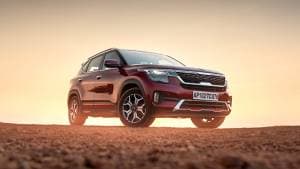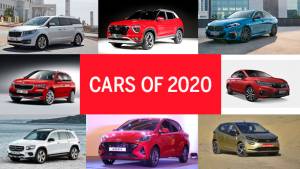2020 Kia Carnival road test review
Going by the looks the Carnival was getting as we were driving around for this review, it should have people lining up at showrooms. It really is quite strange to see passersby and other drivers crane their necks to get a second glance at an MPV of all things, but that's exactly what the Carnival inspires. So far, so good, then. While we first drove the 7, 8 and 9-seater versions of the Carnival back in January, we reckon the subsequent lockdown hasn't really given Kia a chance to sell as many as they would have hoped, leaving the Carnival a far rarer sight on our roads than its closest-yet-distant competition, the Toyota Innova Crysta. Which means it's as good a time as any to put the range-topping Limousine 7-seater variant through our road test routine.

How does it look?
Like we said, the Carnival sets an excellent first impression, novelty aside. It's a big car, at over 5m long but it hides its dimensions well, and even manages to look bloody sleek while at it! Measuring in at a length of 5,111mm, and a height of 1,755mm with a 3,060mm long wheelbase, that's quite an achievement. In keeping the roofline relatively low, and with a low ride height, I think the Carnival manages to look like it's been mildly stanced, in stark contrast to the MPVs on sale in India currently, which either tend toward a more upright SUV look, or go all-out van.


It's a look that's complemented very well by Kia's large signature tiger nose grille which really adds the impression of width and helps square things off nicely. Thankfully, the grille is in a brushed aluminium finish and not chrome, considering there's a healthy dose of the shiny stuff on the 18-inch wheels. Wrapped in 235/60 section rubber, there's a fairly meaty look to them. For those cringing at the thought of chrome wheels, a brief drive gets them dusty and takes off the eye-squintingly bright finish. And to make a quick mention of the ride height, the Carnival didn't ground out anywhere, even when we were trying.


First, how's the cabin?
As expected from its generous proportions, the cabin is pretty cavernous. Despite the low ride height, it's a bit of stretch into the driver's seat, with a wide central console running between you and your co-driver, nearly meeting the norms for social distancing in the front itself! The two-tone colours lift the ambience up, and it's a functional layout with largely premium-feeling materials used but other than the space on offer, there's little to make you feel special. Sure, the seats up front are large, comfortable and surprisingly well bolstered, with the driver's seat getting an 8-way power adjust and ventilation but the general age of the Carnival (this third-gen car was launched internationally in 2015) makes its presence felt.

You can see it in the relative simplicity of the digital information panel between the analogue dials, and in the way the recessed 10.1-inch touchscreen infotainment is laid out. It's a similar story with the touchscreen mounted behind the front seats, which can connect to the internet via your phone's hotspot and play YouTube videos, or via HDMI.


Unfortunately, the screen's brightness, resolution and super glossy finish keep it from being truly useful during the day. And while the list of features is fairly lengthy, and you're not left wanting for much, the lack of automatic wipers does pinch on a day with scattered rain.

The captain seats in the second row are really where the Carnival feels the most special, with soft cushioning that you just sink into. And while the third row is still plenty usable, adults may not want to be stuck there for a long journey. Considering that the third row won't be used all the time, the captain seats (which also slide sideways for entry to the third row) could've used a wider range of adjustment rearward, considering your feet brush up against the seatbacks when you stretch out, or raise the leg supports.


Again, there's zero to fault with the comfort of the seats, which stand a level above those on, say an Innova Crysta, but with no storage options when you're settled in them, you will have to lean forward. Of course, there's no comparison to the supreme comfort of the captain seats of the Vellfire, but it's more than comparable to the rear seat comfort of the Mercedes-Benz V-Class. As for the boot capacity, it's 540-litres, even with the third row up, expanding to a cavernous 1,624 litres with split-seats folded flat against the floor.


How does it drive?
The 2.2-litre diesel motor may sound like only a patch on the bigger engine the Crysta used to be available with, but its 200PS and 440Nm of torque is perfectly routed to the front wheels via an excellent 8-speed automatic. Despite somewhat laid-back reactions from the gearbox, the engine feels eager and never feels like you've caught it sleeping. Even a gentle nudge of the throttle has the 2.2 tonne Carnival respond like it's a smaller SUV, whilst not feeling snappy or restless.

In our testing, we managed a 10.3s run to 100kmph from standstill, which is very quick indeed. In our roll-on tests, for example, the Carnival took 1.6s to go from 30kmph to 50kmph, great figures comparable to smaller luxury cars with similar engine power outputs.
The motor sounds fairly refined while it's at it, too. Clattery old diesel, this is not. At a steady highway cruising speed of 120kmph, the Carnival's ultra relaxed, ticking over at just below 2,000rpm. It posted a 12.9kmpl figure on our highway loop, which dropped to 9.8kmpl in the city.
Another area where the Carnival surprises is in it braking, offering relatively short stopping distances, coming to a standstill from 100kmph in 43.8m and 3.4s. Of course, you do have to push the brake pedal in past the initial soft response to get real bite. As a chauffeur-driven car, it'll prove to be a great tool towards a smooth drive, with predictable responses and great modulation. This helps when you get to the twisties, with the Carnival slowing down without excessive dive, though carrying a fair turn of speed through a corner is met with mild lean.

The key to the overall comfort, even when upping the pace, is how progressively it leans. Though, the hydraulic power steering can feel a little too light at speed, and heavy and jittery at lower speeds which isn't the order you'd expect. Similarly, the Carnival's MacPherson/multi-link suspension setup picks up smaller defects in the road surface at lower speeds, but improves considerably as the speeds rise.
Verdict
The Carnival Limousine is an expensive proposition at over Rs 40 lakh on road, Mumbai, but it does offer superlative comfort for the price. It's an easier car to climb into than an SUV, but at the price it's got stiff competition from everything from the top variants of the Innova Crysta which are nearly Rs 10 lakh more affordable, to other 7-seater SUVs like the Ford Endeavour, Toyota Fortuner and even the Skoda Kodiaq. It's a tough ask at the price but more than delivers for the niche. Overall, it sets the stage quite nicely for the fourth-gen Carnival which has just been revealed, and should make its way here in a couple of years.

Photos: Anis Shaikh
Starts Rs 24.95 Lakhs
2143cc
Automatic
200
440
-NA-
Starts Rs 32.75 Lakhs
1996cc
Automatic
170
420
13.9 Kmpl
Starts Rs 68.4 Lakhs
1950cc
Automatic
165
380
-NA-
Starts Rs 34.99 Lakhs
1984cc
Automatic
190
320
12.78 Kmpl
Starts Rs 29.98 Lakhs
2755cc
Automatic
166
500
-NA-
Starts Rs 16.26 Lakhs
2393cc
Automatic
150
360
-NA-













